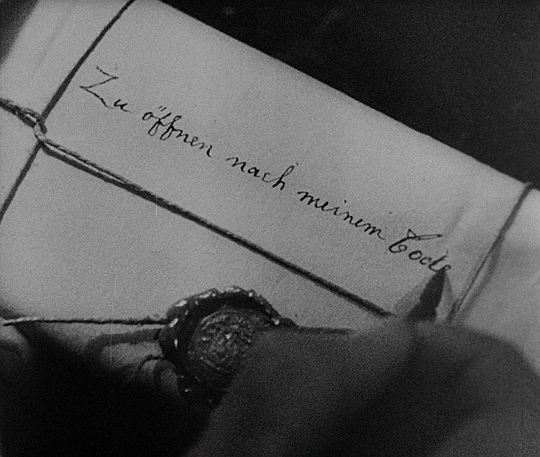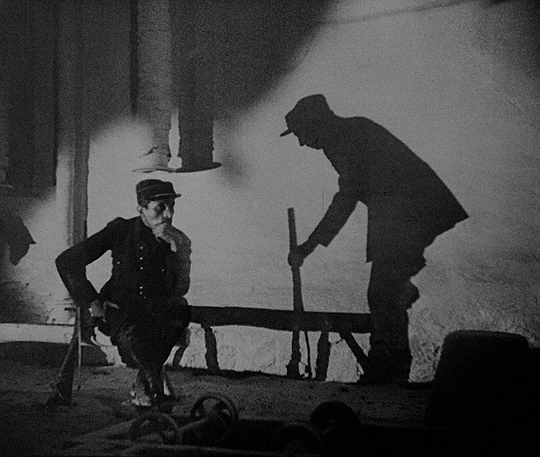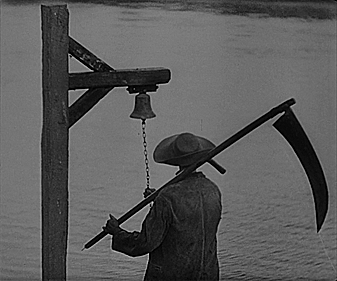Somos seres altamente sugestionáveis.
Os que se assustam facilmente são capazes de pular ao ouvir qualquer barulho ou
ver uma sombra. Os entusiastas do horror também acabam se tornando
sugestionáveis, pois quanto mais eles aprendem sobre o sobrenatural, mais tênue
se torna a linha entre a realidade e o sobrenatural. É exatamente isso que
acontece com nosso herói, Allan Gray, no filme “O Vampiro” (1932), de Carl
Theodor Dreyer.
We’re highly suggestible beings. The easily scared
jump whenever they hear a sound or see a shadow. The horror enthusiasts also
end up becoming suggestible, because the more they learn about the
supernatural, the more blurred the line between reality and the supernatural
becomes. This is exactly what happens with our hero, Allan Gray, in Carl Theodor
Dreyer’s “Vampyr” (1932).
Allan Gray (Julian West) é um
estudante do sobrenatural. Uma tarde, ele está passeando distraído quando
encontra uma hospedaria em uma pequena vila, onde ele decide passar a noite.
Seus terrores noturnos não são mostrados, mas descritos por uma longa cartela
de títulos. Pela manhã, um homem entra no quarto de Allan, diz a ele que “ela
não pode morrer” e deixa um pacote escrito “que só pode ser aberto após sua
morte”.
Allan Gray (Julian West) is a student of the
supernatural. One evening, he’s wandering around when he finds a small inn in a
village, where he decides to spend the night at. His nightly terrors are not
shown, but described in a long title card. In the morning, a man enters Allan’s
bedroom, tells him that “she mustn’t die” and leaves a package “to be opened
when he is dead”.
Mais tarde, Allan segue algumas
sombras sem corpos e testemunha a morte do homem. Logo após o homem morrer,
Allan abre o pacote e lá encontra um livro sobre vampiros. Allan então vê a
filha do homem, Léone (Sybille Schmitz), ser mordida no pescoço. Um médico
muito suspeito chega para cuidar dela. Agora Allan precisará impedir que Léone
viva a eternidade como vampiro.
Later, Allan follows a few shadows without bodies
and witnesses the man’s death. Right after the man dies, Allan opens the
package and there he finds a book about vampires. Allan then witnesses the
man’s daughter, Léone (Sybille Schmitz), being bitten on the neck. A very
suspect doctor arrives to take care of her. Now Allan will be needed to save
Léone from living eternity as a vampire.
O texto constante e enorme na tela
quebra o ritmo do filme e, embora seja didático e importante para a história,
atrapalha mais do que ajuda. “O Vampiro” foi concebido como um filme mudo, mas
os planos mudaram durante a produção e o diálogo teve de ser gravado após as
filmagens. Ainda assim há pouco diálogo no filme, o que, junto com a música de tensão,
ajuda a criar suspense.
The constant and huge text in the screen breaks the
film’s pace and, although didactical and important to the story, it bothers
more than it helps. “Vampyr” was conceived as a silent movie, but the plans
changed during production and the dialogue had to be recorded after shooting.
There is still very little dialogue in the final film, which, along with the
tense music, builds suspense.
O destaque em “O Vampiro” é, sem
dúvida, uma sequência muito claustrofóbica num caixão, filmada do ponto de
vista da pessoa que está no caixão. Visualmente, todo o filme é hipnotizante, e
outras sequências brilhantes incluem sombras, corpos que são quase
transparentes e uma sequência de sonho com um esqueleto. O diretor de
fotografia Rudolph Maté – de “A Paixão de Joana D’Arc” (1928), também de Dreyer
– fez maravilhas ao filmar estas sequências.
The highlight of “Vampyr” is, without a doubt, a
very claustrophobic coffin scene, filmed from the perspective of the person in
the coffin. Visually, the whole film is hypnotizing, and other brilliant sequences
include shadows, bodies that are nearly transparent and a dream sequence with a
skeleton. Cinematographer Rudolph Maté – from Dreyer’s previous film, “The
Passion of Joan of Arc” (1928) – did wonders while shooting these scenes.
Assim como na maioria dos filmes de
Carl Theodor Dreyer, quase todos os atores são amadores. Uma exceção importante
em “O Vampiro” é Léone, a protagonista, interpretada por Sybille Schmitz.
Nascida na Alemanha, ela trabalhou no teatro com Max Reinhardt e se tornou
bastante popular na década de 1930. Em “O Vampiro”, sua expressão de desejo por
sangue é ao mesmo tempo assustadora e fascinante. Sybille continuou trabalhando
no cinema durante o Terceiro Reich, mas em papéis menores e fazendo femme fatales, porque ela não parecia “ariana
o suficiente”. Por causa de seu vínculo empregatício sob o governo de Hitler,
ela caiu no ostracismo a partir de 1945, e começou a abusar das drogas e do
álcool. Sybille cometeu suicídio em 1955, e seus últimos anos serviram de base
para o brilhante filme de 1982 “O Desespero de Veronika Voss”, de Rainer Werner
Fassbinder.
Like in most Carl Theodor Dreyer films, almost all
actors are amateurs. One important exception in “Vampyr” is Léone the leading
lady, played by Sybille Schmitz. Born in German, she worked in theater under
famous director Max Reinhardt and became quite popular in the 1930s. In “Vampyr”,
her expression of lust for blood is at the same time scary and fascinating.
Sybille kept on working in film during the Third Reich, but in smaller roles
and as femme fatales, because she didn’t look “Aryan enough”. Because of this
continuous employment under Hitler, she was ostracized after 1945, and started
abusing drugs and alcohol. Sybille committed suicide in 1955, and her final
years were the basis for the brilliant 1982 film “Veronika Voss”, by Rainer
Werner Fassbinder.
 |
| Sybille Schmitz |
Nicolas de Gunzburg, um herdeiro
francês vindo de uma família nobre russa, financiou o filme com uma condição:
ele deveria ser escolhido para o papel principal. Foi assim que Nicolas adotou
o nome artístico Julian West. Nicolas / Julian nunca fez outro filme, mas se
tornou famoso no mundo da moda como editor de revistas de moda como Vogue e
Harper’s Bazaar. Aliás, você percebeu como ele e H.P. Lovecraft se pareciam?
Nicolas de Gunzburg, a French heir from a noble
Russian family, financed the film with one condition: he should be given the
leading role. That’s how Nicolas adopted the stage name of Julian West. Nicolas
/ Julian never made another film, but he became a famous figure in the fashion
world as editor of fashion magazines such as Vogue and Harper’s Bazaar. By the
way, do you see how much he and H.P. Lovecraft look alike?
 |
| Nicolas / Julian |
Como acontecia nos primeiros filmes
falados, em “O Vampiro” o diálogo foi gravado em diversas línguas para que o
filme pudesse ser exportado para vários países. A versão em inglês foi perdida –
embora alguns estudiosos digam que tal versão não foi sequer finalizada. Cópias
em alemão e francês foram usadas para restaurar o filme à versão que temos
hoje, com 73 minutos de duração. Ainda há algumas sequências perdidas.
Like it was common with early talkies, in “Vampyr”
the dialogue was also recorded in several languages in order to export the film
to several countries. The English version is lost – although some scholars
claim that this version was never even completed. Prints in German and French
were used to restore the film to the version we have today, and it is 73
minutes long. There are still some sequences lost.
Carl Theodor Dreyer disse que, com “O
Vampiro”, ele quis “fazer um filme diferente de todos os outros filmes” e “criar
um sonho na tela e mostrar que o horror não é encontrado nas coisas ao nosso
redor, mas em nosso subconsciente”. Ele conseguiu fazer as duas coisas, mas
pagou um preço alto: “O Vampiro” foi um fracasso de bilheteria e esgotou o
diretor emocional e financeiramente. Dreyer fez apenas mais quatro filmes, se
aposentando em 1964. Mas “O Vampiro” resistiu ao teste do tempo, e agora é
considerado um clássico experimental e cult, e suas imagens ainda assombram
nossas mentes.
Carl Theodor Dreyer said that, with “Vampyr”, he
wanted to “make a film different from all other films” and “to create a dream
on scream and show that horror is not to be found in the things around us but
in our own subconscious”. He ended up achieving both, but paid a high price: “Vampyr”
was a box-office failure and drained the director emotionally and financially.
Dreyer made only four more films, retiring in 1964. But “Vampyr” stood the test
of time, and now it’s highly regarded as a cult, experimental classic, and its
images are still hunting our minds.
This is my contribution to the Dark and Deep: The Gothic Horror Blogathon, hosted by Gabriela at Pale Writer.











3 comments:
Vampyr is certainly one of the most atmospheric horror movies I have ever seen. I think the fact that it has very little dialogue actually helps in building the film's atmosphere. I do have to agree with you about the title cards though. I think sometimes they tend to distract more than help.
Very good article, Le! I've also seen this movie and I agree with a lot of the points that you made in your review. In fact, I wrote a review for this film as well, so here's the link if you want to check it out!
https://18cinemalane.wordpress.com/2019/10/14/take-3-vampyr-review-145-follower-thank-you/
When I first watched this film I was utterly fascinated, as was my mother. We didn’t know quite what to make of it. As you so aptly put it, it is an absolute visual masterpiece, and I can see why people were not quite ready for it. My favourite sequence is the one you showed with the disembodied shadow, I also love the part with the coffin, and the ending, with the burying of the Vampire, is incredibly well done. I can see that the lead actor wasn’t a professional, but Dreyer really does manage to guide him effectively. As a mood piece, this film is outstanding. Thanks so much for contributing such a fascinating article to my Blogathon.
Post a Comment